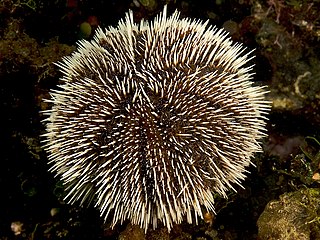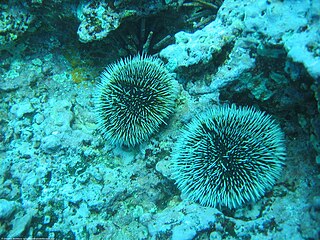Related Research Articles

Sea urchins, are typically spiny, globular animals, echinoderms in the class Echinoidea. About 950 species live on the seabed, inhabiting all oceans and depth zones from the intertidal to 5,000 metres. Their hard shells (tests) are round and spiny, usually from 3 to 10 cm across. Sea urchins move slowly, crawling with their tube feet, and sometimes pushing themselves with their spines. They feed primarily on algae but also eat slow-moving or sessile animals. Their predators include sea otters, starfish, wolf eels, triggerfish, and humans.

Tube feet are small active tubular projections on the oral face of an echinoderm, whether the arms of a starfish, or the undersides of sea urchins, sand dollars and sea cucumbers; they are more discreet though present on brittlestars, and have only a feeding function in feather stars. They are part of the water vascular system.

Diadema setosum is a species of long-spined sea urchin belonging to the family Diadematidae. It is a typical sea urchin, with extremely long, hollow spines that are mildly venomous. D. setosum differs from other Diadema with five, characteristic white dots that can be found on its body. The species can be found throughout the Indo-Pacific region, from Australia and Africa to Japan and the Red Sea. Despite being capable of causing painful stings when stepped upon, the urchin is only slightly venomous and does not pose a serious threat to humans.

Heterocentrotus mamillatus, commonly known as the slate pencil urchin, red slate pencil urchin, or red pencil urchin, is a species of tropical sea urchin from the Indo-Pacific region.

Tripneustes ventricosus, commonly called the West Indian sea egg or white sea urchin, is a species of sea urchin. It is common in the Caribbean Sea, the Bahamas and Florida and may be found at depths of less than 10 metres (33 ft).

Toxopneustes pileolus, commonly known as the flower urchin, is a widespread and commonly encountered species of sea urchin from the Indo-West Pacific. It is considered highly dangerous, as it is capable of delivering extremely painful and medically significant stings when touched. It inhabits coral reefs, seagrass beds, and rocky or sandy environments at depths of up to 90 m (295 ft). It feeds on algae, bryozoans, and organic detritus.

Toxopneustidae is a family of globular sea urchins in the class Echinoidea.

The Camarodonta are an order of globular sea urchins in the class Echinoidea. The fossil record shows that camarodonts have been in existence since the Lower Cretaceous.

Zebrida is a small genus of distinctive striped crabs, known as zebra crabs, that live in association with sea urchins in the Indo-Pacific.

Tripneustes is a genus of sea urchins belonging to the family Toxopneustidae.

Tripneustes depressus, the white sea urchin or sea egg, is a species of sea urchin in the family Toxopneustidae. It is found on the seabed in the tropical eastern Pacific Ocean including Mexico, Panama, Ecuador and the Galápagos Islands.
Syndesmis longicanalis is a species of marine flatworms endemic to the waters off Kenya. They are commensal symbionts of sea urchins.

Athanas areteformis is a species of small alpheid shrimp from the Indo-West Pacific.
White sea urchin is a common name for several sea urchins and may refer to:
Nocardioides is a Gram-positive, mesophilic and aerobic bacterial genus from the family of Nocardioidaceae.
Nocardioides salarius is a bacterium from the genus of Nocardioides which has been isolated from zooplankton from the South Sea near Korea.
Chryseobacterium echinoideorum is a Gram-negative, rod-shaped, aerobic and non-motile bacteria from the genus of Chryseobacterium which has been isolated from a sea urchin on the Penghu Island on Taiwan. Chryseobacterium echinoideorum produces flexirubin.
Aequorivita echinoideorum is a Gram-negative, rod-shaped and aerobic bacterium from the genus of Aequorivita which has been isolated from a sea urchin from Penghu Island in Taiwan.
References
- 1 2 Parte, A.C. "Nocardioides". LPSN .
- 1 2 "Nocardioides echinoideorum". www.uniprot.org.
- ↑ Lin, SY; Wen, CZ; Hameed, A; Liu, YC; Hsu, YH; Shen, FT; Lai, WA; Young, CC (June 2015). "Nocardioides echinoideorum sp. nov., isolated from sea urchins (Tripneustes gratilla)". International Journal of Systematic and Evolutionary Microbiology. 65 (Pt 6): 1953–8. doi: 10.1099/ijs.0.000206 . PMID 25805631.